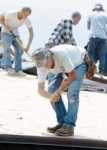Warm temperatures dangerous to some

SIKESTON - As Southeast Missouri enters the dog days of summer, temperatures are steadily increasing, along with the risk of heat-related illnesses.
Tom Robert, a registered nurse at Missouri Delta Medical Center, said that trips to the hospital rise as heat and humidity levels soar. "It (the number of patients) depends, of course, on the heat. Obviously, long periods with temperatures from 95 to 100 degrees will bring more people in," he stated.
Heat-related illnesses occur when the body loses the ability to control its temperature. This can be very dangerous.
Young children and elderly people are at greatest risk for heat-related illnesses, according to Robert. Those taking prescriptions for their health including high blood pressure and heart, lung and kidney problems are also in danger. "People who are overweight and underweight are also at risk," he added.
Elderly people should be checked on when temperatures soar. And those who don't have air conditioning should go to a church or the library, Robert advised The Centers for Disease Control said an electric fan may provide comfort, it will not protect from heat-related illnesses when the temperature is in the upper 90s.
"Dizziness, weakness and cramps," Robert identified as the first symptoms. The CDC includes other warning signs: extremely high body temperature; red, hot, dry skin; lack of perspiration; rapid, strong pulse; throbbing headache; nausea; confusion; and unconsciousness.
If someone is experiencing any of these symptoms, several steps should be taken. Roberts said to go to a cool place, inside if possible, wet down as much of the body as possible with cold water, especially the head and of course and drink water. If the symptoms persist 20 to 30 minutes or consciousness is lost, it is time to see a doctor.
Working at the hospital, Robert has observed many cases of heat-related illnesses. "Most commonly we have people come in who either work or exercise in the heat," he said. Robert explained these people generally don't have a high enough fluid intake to replace what is lost through perspiration, the body's cooling mechanism.
Area businesses are taking steps to help their workers stay cool and avoid illness.
Joe Stewart, senior safety officer at the Missouri Department of Transportation, said they provide drinks for their workers and conduct heat injury training in the spring. "Our training basically involves identifying the different types of heat fatalities," he said. "We caution them to drink plenty of fluids, take periodic work breaks and dress appropriately."
A training is also provided in the fall to teach workers safety in cooler weather. All workers are required to take these workshops, no matter how long they have worked at MoDOT, according to Stewart.
Pyramid Roofing Company also implements preventative measures with their employees. "We provide Gatorade, salt tablets and plenty of water," said Lloyd Stoner II, secretary/treasurer. Salt tablets, which restore salt to the body, should not be taken in excess or they could have an adverse effect, he pointed out.
Stoner agreed with Stewart that workers should dress in light, loose clothing and drink plenty of fluids. He added a few more tips. "We advise them to get a good night's sleep and eat moderately when it will be hot," Stoner remarked.
The amounts and types of fluids consumed should also be taken into consideration. Robert recommended 24 to 32 ounces of fluids per hour. These drinks can be water, fruit juices or sports drinks. He warned not to drink caffeine or alcoholic beverages.
Robert and Stoner agreed that it is not a good idea to drink extremely cold drinks, which can cause abdominal cramping. Stoner suggested drinking a mixture of fluids. "While electrolytes (found in sports drinks) are good, too many can be harmful," he said.
Employees working in the heat also learn about the different types of heat illnesses, from identifying them to knowing how to treat them. Pyramid has a chart available to workers, while MoDOT incorporates this into their training. Stoner pointed out that while heat cramps, heat exhaustion and heat stroke are all serious, heat stroke can be extremely critical.
Work hours often change during the summer to keep workers out of the hot sun. Pyramid roofers start work earlier in the morning, while MoDOT reported that their schedule is flexible and some operations, such as pouring concrete, take place at night to escape the heat.
If possible, the CDC recommended staying out of the heat. But for those who are in the blazing temperatures, Robert has one final piece of advice: "be well hydrated and aware of the symptoms."

